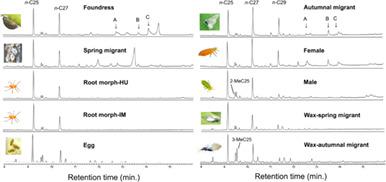当前位置:
X-MOL 学术
›
Entomol. Sci.
›
论文详情
Our official English website, www.x-mol.net, welcomes your
feedback! (Note: you will need to create a separate account there.)
Seasonal changes in cuticular hydrocarbons in response to polyphenism in the host‐alternating aphid Prociphilus oriens
Entomological Science ( IF 0.7 ) Pub Date : 2020-10-27 , DOI: 10.1111/ens.12443 Xin Tong 1 , Yusuke Takata 2 , Shin‐ichi Akimoto 2
Entomological Science ( IF 0.7 ) Pub Date : 2020-10-27 , DOI: 10.1111/ens.12443 Xin Tong 1 , Yusuke Takata 2 , Shin‐ichi Akimoto 2
Affiliation

|
In most terrestrial arthropods, cuticular hydrocarbons (CHCs) function to assist in desiccation tolerance and chemical communications. However, few studies have clarified whether CHC profiles change among developmental stages or among different morphs in non‐social insects. In the present study, we evaluated how CHC profiles change in accordance with polyphenism in the host‐alternating aphid Prociphilus oriens, which exhibits a complex life cycle and five distinct morphs. These morphs are sexual or asexual and adapt to different host plants. We found that all generations of P. oriens shared high proportions of n‐alkanes, but its composition varied among morphs. Three morphs that are attended by ants were characterized by relatively high proportions of n‐C25 to n‐C27, whereas two morphs that are not attended by ants had higher proportions of longer‐chain n‐alkanes, such as n‐C27 and n‐C29. The CHC profiles of sexual females were largely different from those of males. Considering that sexual females of Prociphilus spp. lack organs that secrete sex pheromones (scent plaques), the CHCs of sexual females are likely to function as a sex attractant. High proportions of methyl‐branched alkanes were detected in the long and flocculent waxy substances of autumnal migrants. These methyl‐branched alkanes are considered a cue to recognize conspecifics. We concluded that the functions and components of CHCs differ among morphs, and that those of sexual females differ from those of males and asexual generations because of their function in sexual communication.
中文翻译:

表皮碳氢化合物的季节性变化,响应寄主交替蚜虫Prociphilus oriens中的多态性
在大多数陆生节肢动物中,表皮碳氢化合物(CHC)的作用是辅助耐干燥性和化学通讯。但是,很少有研究澄清非社会性昆虫中CHC谱在发育阶段或不同形态之间是否发生变化。在本研究中,我们评估了寄主交替的蚜虫Prociphilus oriens中CHC谱如何根据多态性变化,其表现出复杂的生命周期和五个不同的形态。这些变体是有性或无性的,并适应不同的寄主植物。我们发现所有世代疟原虫共享高比例的正构烷烃,但其组成因形态而异。蚂蚁参与的三种变体的特征是相对较高的比例n- C25至n- C27,而蚂蚁不参与的两个变体的长链正构烷烃比例更高,例如n- C27和n- C29。性女性的CHC特征与男性的CHC特征大不相同。考虑到Prociphilus的性女性spp。由于缺乏分泌性信息素(气味斑块)的器官,性女性的CHC可能起性吸引剂的作用。在秋季移徙者的长而絮状的蜡状物质中检测到高比例的甲基支链烷烃。这些甲基支链烷烃被认为是识别特定物种的线索。我们得出的结论是,不同形态的CHC的功能和组成各不相同,而有性的女性则由于其在性交中的作用而不同于男性和无性世代。
更新日期:2020-10-27
中文翻译:

表皮碳氢化合物的季节性变化,响应寄主交替蚜虫Prociphilus oriens中的多态性
在大多数陆生节肢动物中,表皮碳氢化合物(CHC)的作用是辅助耐干燥性和化学通讯。但是,很少有研究澄清非社会性昆虫中CHC谱在发育阶段或不同形态之间是否发生变化。在本研究中,我们评估了寄主交替的蚜虫Prociphilus oriens中CHC谱如何根据多态性变化,其表现出复杂的生命周期和五个不同的形态。这些变体是有性或无性的,并适应不同的寄主植物。我们发现所有世代疟原虫共享高比例的正构烷烃,但其组成因形态而异。蚂蚁参与的三种变体的特征是相对较高的比例n- C25至n- C27,而蚂蚁不参与的两个变体的长链正构烷烃比例更高,例如n- C27和n- C29。性女性的CHC特征与男性的CHC特征大不相同。考虑到Prociphilus的性女性spp。由于缺乏分泌性信息素(气味斑块)的器官,性女性的CHC可能起性吸引剂的作用。在秋季移徙者的长而絮状的蜡状物质中检测到高比例的甲基支链烷烃。这些甲基支链烷烃被认为是识别特定物种的线索。我们得出的结论是,不同形态的CHC的功能和组成各不相同,而有性的女性则由于其在性交中的作用而不同于男性和无性世代。











































 京公网安备 11010802027423号
京公网安备 11010802027423号